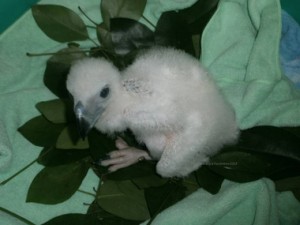
LONG LIVE. Philippine eagle Mabuhay on March 8, a day before turning one month old. (contributed photo/Ana Mae Sumaya)
” The zero human contact is to prevent the eagle from being imprinted and easier for the PEF (Philippine Eagle Foundation) to decide later on if the eagle is for release or for breeding.” — Anna Mae Sumaya, PEF’s curator for conservation breeding
By MEDEL V. HERNANI
Davao Today
DAVAO CITY, Philippines – One-month old Mabuhay, the 25th captive-bred Philippine eagle, now weighs a kilogram but it still cannot be shown or exposed to humans.
“The zero human contact is to prevent the eagle from being imprinted and easier for the PEF (Philippine Eagle Foundation) to decide later on if the eagle is for release or for breeding,” said Anna Mae Sumaya, PEF’s curator for conservation breeding, in an interview Saturday.
Mabuhay is the first offspring of Pag-asa, the first Philippine eagle hatched and bred in captivity. Its mother is Kalinawan, a 29-year old female eagle rescued from Zamboanga del Sur in 2009.
Pag-asa finally sired an offspring after 21 years, said PEF communications officer Roli Pinsoy. Kalinawan was inseminated with Pag-asa’s semen through cooperative artificial insemination, he added.
Mabuhay weighed 158 grams when it was hatched last February 9 at 1:55 AM. “It now weighs about 1 Kilogram and consumes about 70 to 80 grams of ground quail meat per day,” Sumaya said. “Its sex will be known after a year,” she added.
Sumaya recalled that she had to help Mabuhay to successfully break from its shell last month “to avoid damaging the vital veins that could potentially cause its death” because the chick then hatched from a breeched position.
Mabuhay’s name was given by the sponsor “who shoulders its yearly food, veterinary needs, maintenance and other expenses,” Pinsoy said.
Mabuhay is the first of third generation of Philippine eagles bred at the Philippine Eagle Center (PEC) where there are currently 36 Philippine Eagles, 18 of which are captive-bred. There are also 10 other species of birds, four species of mammals and two species of reptiles, said the PEF in its website.
In an earlier statement, Dennis Salvador, Executive Director of PEF said that they still need to restore the Philippine eagles’ population and its natural habitat despite having Mabuhay and despite investing a lot of time, effort and resources to conserve the Philippine eagle.
“We are still worried about the fate of the Philippine eagles in the wild. We breed Philippine eagles to replace population losses in the wild but we are uncertain of their safety once they are released. They are constantly under threat of human persecution,” he said.
The PEF said that breeding Philippine eagles in captivity “remains difficult.”
“We are certainly a long way off in coping with losses in the wild. The Philippine eagles and their forest habitat continue to be imperiled by man-made activities like logging, mining and other development projects,” Salvador said. (Medel V. Hernani/davaotoday.com)










